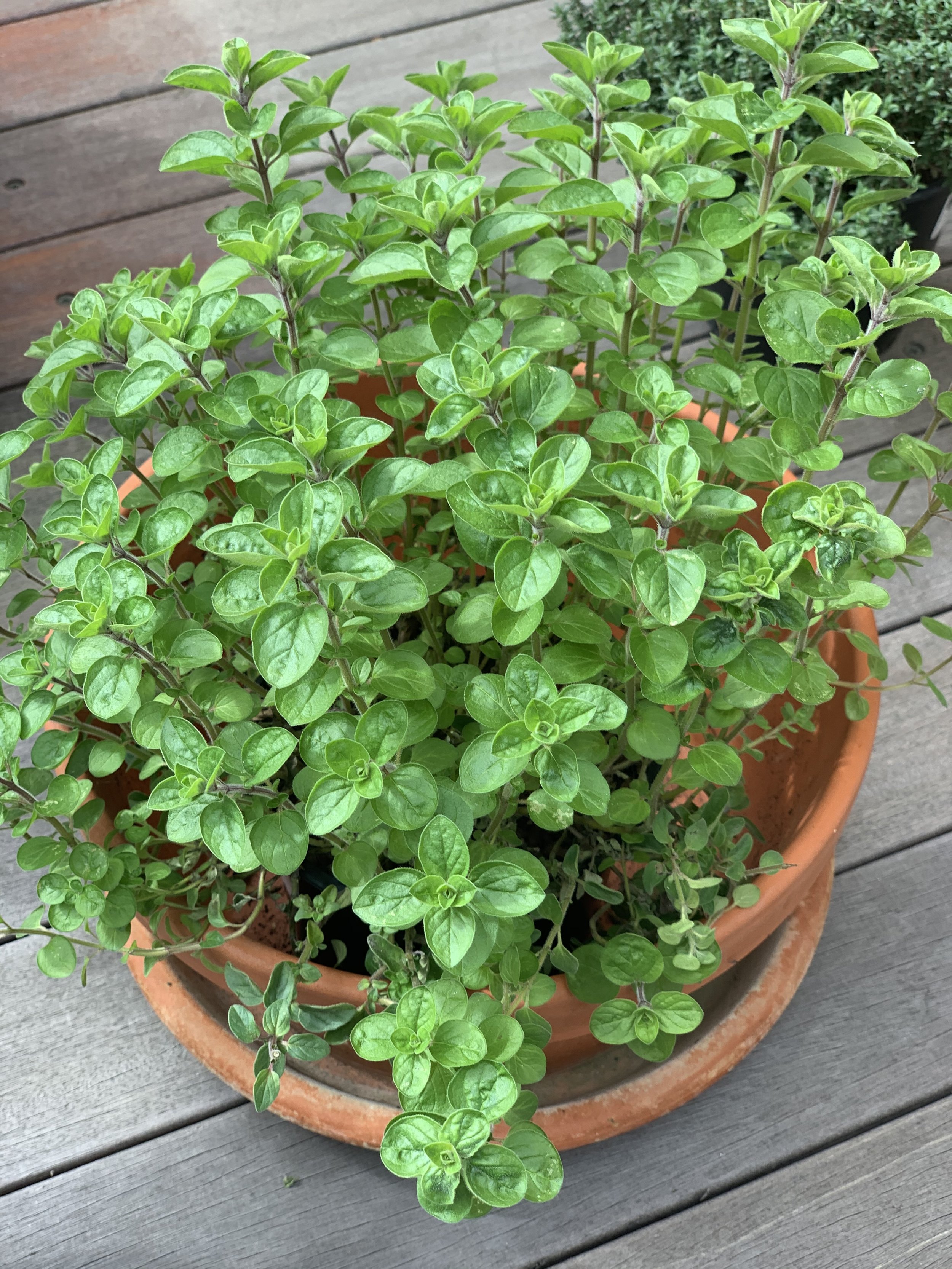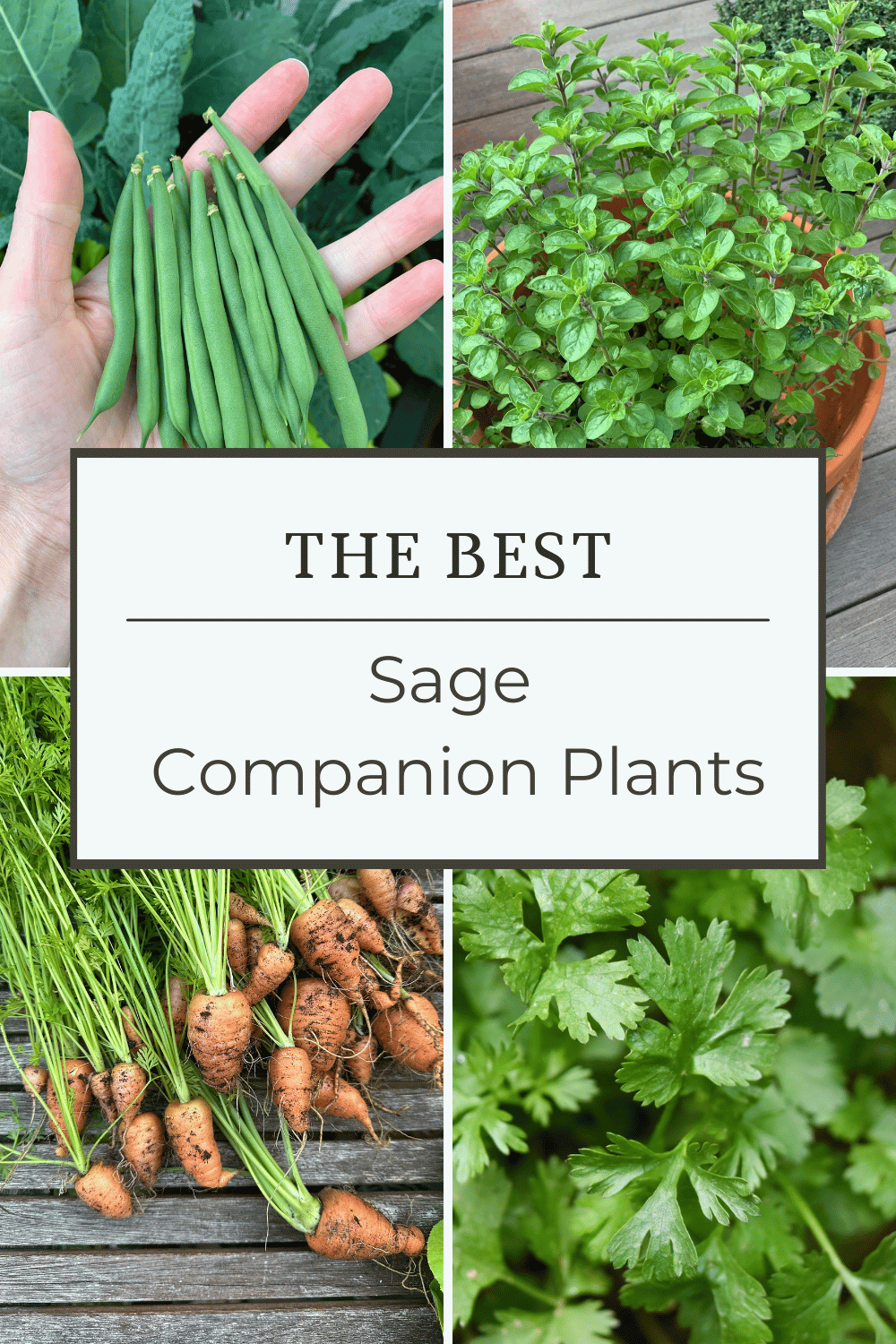Sage Companion Plants: Boost Your Garden's Health
This website is reader-supported - thank you! This post may contain affiliate links. As an Amazon Associate, I earn from qualifying purchases at no extra cost to you.
Companion planting is an age-old gardening technique that brings together different plants to create a harmonious and productive garden.
For those cultivating an herb garden, understanding how to pair plants effectively can significantly boost growth and yield.
Sage, one of my favorite herbs, is an excellent candidate for companion planting.
By strategically pairing sage with other plants, you can attract beneficial insects, improve soil health, and repel common pests.
In this guide, we'll explore the best and worst sage companion plants, the benefits of companion planting, and tips on how to get the most out of your herb garden.
To learn more about growing sage, check out my guides:
For more herb garden tips, check out my guide: Herbs That Can Be Planted Together: The Best Combinations.
Best Companion Plants for Sage
Sage is a versatile herb that pairs well with a variety of plants, creating a mutually beneficial environment in your garden.
Here are the best companions for sage and how they contribute to a thriving garden ecosystem:
Carrots:
Carrot rust flies can be a significant problem for carrot crops.
Sage's strong scent deters these pests, protecting your carrots and promoting healthy root development.
Additionally, carrots and sage don't compete for the same soil nutrients, making them excellent companions.
Here are the carrots I recommend growing:
Brussels Sprouts:
Brussels sprouts are prone to pests like cabbage moths and cabbage worms.
Sage helps repel these pests, allowing your Brussels sprouts to grow without significant pest-related issues.
This pairing is particularly beneficial in organic kitchen gardens where chemical pest control is minimized.
Here are the Brussels sprouts I recommend growing:
Beans:
Beans and sage make a great combination because beans help fix nitrogen in the soil, benefiting sage and other nearby plants.
This natural soil enrichment improves overall plant health and growth.
Additionally, sage's pest-repelling properties protect beans from common garden pests.
Here are the beans I recommend growing:
Oregano:
Oregano and sage are both aromatic herbs that attract beneficial insects such as bees and ladybugs.
These insects aid in pollination and help control harmful pests.
Planting oregano near sage can enhance the biodiversity of your garden, leading to a more balanced ecosystem.
Here is the oregano I recommend growing:
Rosemary:
Rosemary and sage have similar growing requirements, preferring full sun and well-drained soil.
Planting these herbs together ensures they receive the conditions they need to thrive.
Additionally, both herbs can repel a variety of pests, creating a protective barrier for other plants in your garden.
Here is the rosemary I recommend growing:
Parsley:
Parsley and sage can coexist harmoniously in the garden.
Parsley attracts beneficial insects that prey on common pests, providing natural pest control.
Additionally, sage can help protect parsley from pests like aphids, making this combination particularly effective for maintaining plant health.
Here is the parsley I recommend growing:
For more herb garden tips, check out my guides:
Bad Companion Plants for Sage
While sage is a great companion to many plants, it can have a negative impact on the growth of certain plants.
Avoid planting these plants near sage to prevent growth inhibition and competition for resources:
Cucumbers:
Sage can inhibit the growth of cucumber plants.
Cucumbers are heavy feeders and require ample nutrients and water, which can lead to competition when planted near sage.
Additionally, cucumbers prefer slightly more acidic soil compared to the alkaline preference of sage.
This difference in soil pH needs can cause nutrient imbalances, affecting the health and productivity of both plants.
Onions:
Onions and sage do not grow well together because they compete for similar nutrients in the soil.
Both plants require a lot of nitrogen, and planting them together can lead to nutrient deficiencies, resulting in stunted growth and reduced yields.
Furthermore, onions can release chemicals into the soil that inhibit the growth of sage, making them poor companions.
Strawberries:
Sage and strawberries should be planted separately to avoid growth issues.
Strawberries are shallow-rooted plants that require a lot of moisture, while sage prefers drier conditions.
This difference in water needs can create an unfavorable environment for both plants.
Additionally, sage can inhibit the growth of strawberries by competing for space and nutrients in the soil.
Check out my guide:
Why Companion Planting?
Companion planting is a gardening technique that involves growing different plants in close proximity to create a mutually beneficial relationship.
This practice has been used for centuries and offers several advantages that contribute to a healthier and more productive garden.
Here are some key reasons why companion planting is beneficial:
Pest Control
One of the primary benefits of companion planting is natural pest control.
Certain plants can repel harmful insects or attract beneficial ones that prey on garden pests.
For example, sage is known to repel pests like flea beetles, cabbage moths, and carrot rust flies.
By planting sage near vulnerable crops, you can reduce the need for chemical pesticides, creating a safer and more eco-friendly garden.
Attracting Beneficial Insects
Companion planting can attract beneficial insects such as bees, ladybugs, and predatory wasps.
These insects play crucial roles in pollination and pest control.
For instance, planting herbs like oregano and flowers like marigolds alongside sage can attract pollinators and beneficial predators, enhancing the overall health and productivity of your garden.
Weed Suppression
Some companion plants can help suppress weeds by shading the soil and outcompeting unwanted plants for resources.
By planting ground covers or fast-growing companions alongside sage, you can reduce the presence of weeds, minimizing the need for manual weeding and chemical herbicides.
How to Plant Sage with Companions
Successfully planting sage with companion plants requires a thoughtful approach to garden planning and maintenance.
Here are some detailed steps to help you get started:
Choose the Right Spot
Selecting an appropriate location for your sage and its companions is crucial.
Sage thrives in full sun and well-drained soil.
Ensure the spot you choose receives at least six hours of direct sunlight each day, such as a south-facing spot.
The soil should be sandy or loamy with good drainage to prevent waterlogging, which can lead to root rot.
Prepare the Soil
Before planting, prepare the soil by adding organic matter such as compost or well-rotted manure.
This improves soil fertility and structure, providing essential nutrients for your plants.
Test the soil pH and aim for a slightly alkaline to neutral pH range (6.0-7.0) to create an optimal growing environment for sage and its companions.
Here is the soil pH tester I recommend:
Space Appropriately
Proper spacing is essential to avoid overcrowding and competition for resources.
Here are some general spacing guidelines for planting sage with its companions:
Sage: Space sage plants about 18-24 inches apart.
Tomatoes: Space tomato plants about 24-36 inches apart.
Carrots: Space carrot rows about 12-18 inches apart.
Brussels Sprouts: Space Brussels sprouts about 18-24 inches apart.
Beans: Space bush beans about 4-6 inches apart in rows 18-24 inches apart.
Oregano: Space oregano plants about 12-18 inches apart.
Rosemary: Space rosemary plants about 24-36 inches apart.
Parsley: Space parsley plants about 6-8 inches apart.
These spacing guidelines ensure each plant has enough room to grow and access sunlight, water, and nutrients.
Plan the Layout
Design your garden layout to group compatible plants together while keeping incompatible ones apart.
Consider creating distinct sections for herbs, vegetables, and flowers.
For example, plant sage alongside tomatoes, carrots, and oregano in one section, while keeping cucumbers and onions in a separate area.
Rotate Crops
Crop rotation helps prevent soil depletion and reduces the risk of pest and disease buildup.
Avoid planting sage and its companions in the same spot year after year.
Instead, rotate them with other plant families to maintain soil health and fertility.
Water Wisely
Sage is drought-tolerant and prefers dry conditions once established.
Water newly planted sage regularly until it becomes established, then reduce watering to avoid overwatering.
Be mindful of the watering needs of its companion plants:
Tomatoes: Require consistent moisture but avoid waterlogging.
Carrots: Prefer evenly moist soil.
Brussels Sprouts: Need regular watering, especially during dry periods.
Beans: Require consistent watering but avoid wet soil.
Oregano and Rosemary: Both herbs prefer well-drained soil and moderate watering.
Adjust your watering schedule to meet the needs of all plants without overwatering or underwatering any particular one.
Mulch and Weed
Applying mulch around your plants helps retain soil moisture, regulate temperature, and suppress weeds.
Organic mulches such as straw, grass clippings, or compost work well.
Regularly check for and remove weeds to reduce competition for nutrients and water.
Monitor for Pests and Diseases
Keep an eye on your plants for signs of pests and diseases.
Companion planting can help deter many pests, but it’s still important to monitor your garden regularly.
Use organic pest control methods, such as neem oil or insecticidal soap, if necessary.
Encourage beneficial insects like ladybugs and lacewings to keep pest populations in check.
For more herb garden tips, check out my guides:
Quick FAQs
Can sage be planted with vegetables?
Yes, sage can be planted with various vegetables. It pairs well with:
Tomatoes: Helps repel tomato hornworms.
Carrots: Deters carrot rust flies.
Brussels Sprouts: Repels pests like cabbage moths and cabbage worms.
Beans: Benefits from nitrogen fixation by beans, improving soil health.
These combinations create a mutually beneficial environment where vegetables and sage support each other's growth and health.
What soil conditions are best for planting sage?
Sage thrives in specific soil conditions:
Well-Drained Soil: Sage prefers sandy or loamy soil that drains well to prevent waterlogging and root rot.
pH Range: Slightly alkaline to neutral soil with a pH between 6.0 and 7.0 is ideal for sage.
Organic Matter: Adding compost or well-rotted manure improves soil fertility and structure, providing essential nutrients for sage.
Full Sun: Sage needs at least six hours of direct sunlight daily to grow optimally.
Companion planting with sage offers numerous benefits that can enhance the health and productivity of your herb garden.
By carefully selecting the right companion plants, you can naturally repel pests such as black flea beetles, cucumber beetles, and carrot flies, ensuring a thriving garden environment.
Additionally, sage helps attract beneficial insects, promoting pollination and pest control.
Remember to avoid planting incompatible companions to prevent growth inhibition and competition for resources.
With thoughtful planning and care, your sage and its companions will flourish, providing a bountiful harvest and a beautiful, resilient garden.
Pin this post to save it for later!
















































